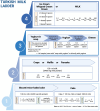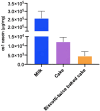Milk ladder: Who? When? How? Where? with the lowest risk of reaction
- PMID: 39713044
- PMCID: PMC11659236
- DOI: 10.3389/falgy.2024.1516774
Milk ladder: Who? When? How? Where? with the lowest risk of reaction
Erratum in
-
Corrigendum: Milk ladder: Who? When? How? Where? with the lowest risk of reaction.Front Allergy. 2025 Mar 14;6:1576302. doi: 10.3389/falgy.2025.1576302. eCollection 2025. Front Allergy. 2025. PMID: 40161855 Free PMC article.
Abstract
The milk ladder (ML) approach, which is the gradual reintroduction of the milk allergen from the least allergenic forms to the most allergenic forms into the diet of the patients, has been utilized mostly in non-IgE-mediated but in some countries also in IgE-mediated-CMPA due to its possible benefits which include nutrition, quality of life and tolerance induction. Despite increasing interest, so far, there is no guideline on ML; thus, the use of this approach shows discrepancies among healthcare professionals as many factors such as dietary habits, patient history, test results, workload, and facilities of the hospitals, the anxiety of the parents/patients may affect the decision on how, when, where and whom to use ML. Here, we reviewed current data on implementing the ML, suggested a 4-step ML including receipts and amounts, and shared our experience on optimal patient selection, appropriate time and steps for initiating ML, and time intervals between the steps targeting the lowest risk of reaction. We also added the newly developed twice-baked biscotti cake to the ML. We presented the analyses of this product, showing its low allergenicity compared to conventional cake, which provides a safer introduction of milk into the diet.
Keywords: baked milk; cow's milk protein allergy; food allergy; food ladder; immunotherapy; nutrition; tolerance induction; treatment.
© 2024 Buyuktiryaki, Soyer, Bingol, Can, Nacaroglu, Bingol, Arik Yilmaz, Aydogan and Sackesen.
Conflict of interest statement
The authors declare that the research was conducted in the absence of any commercial or financial relationships that could be construed as a potential conflict of interest.
Figures






References
Publication types
LinkOut - more resources
Full Text Sources

